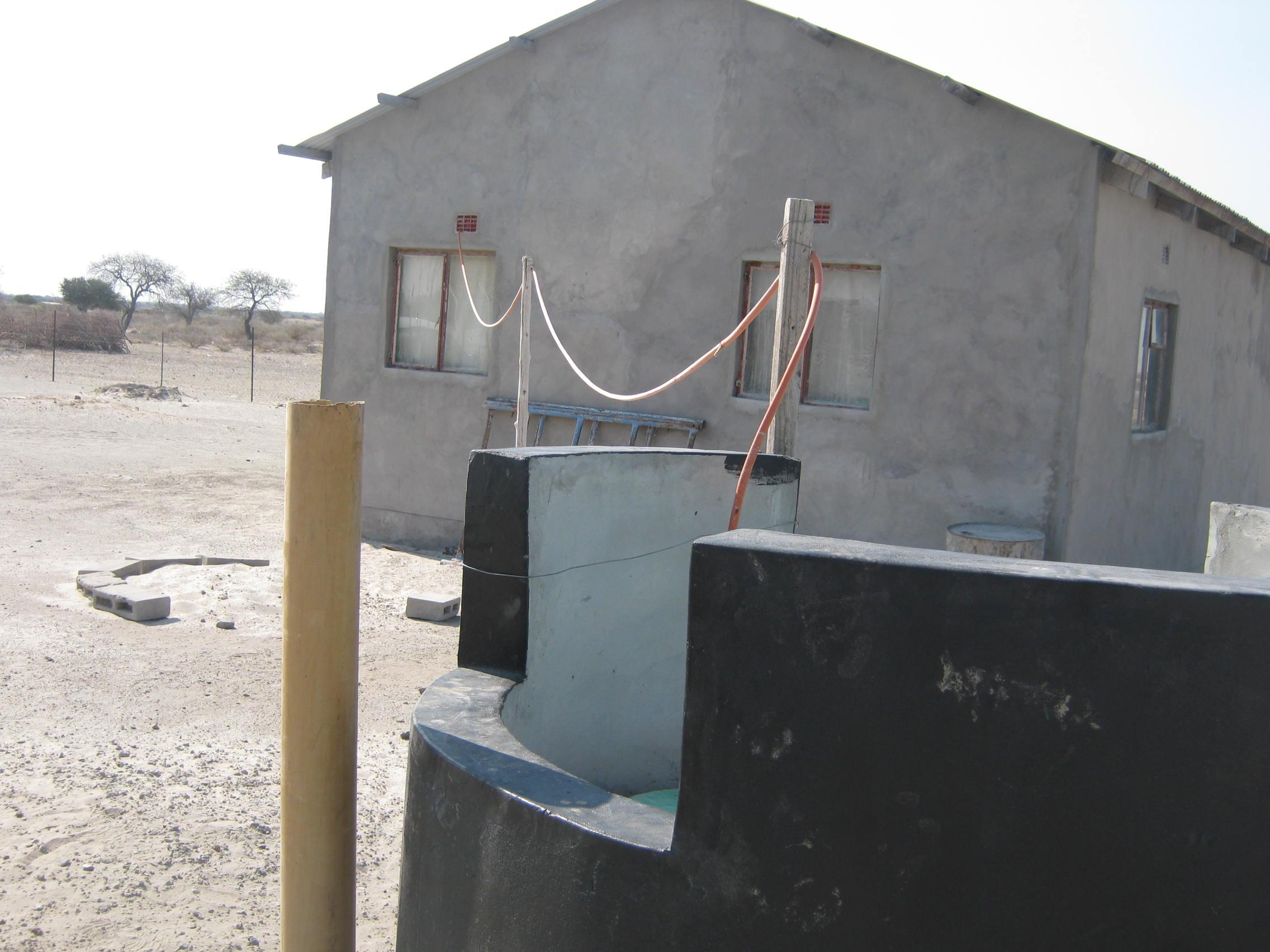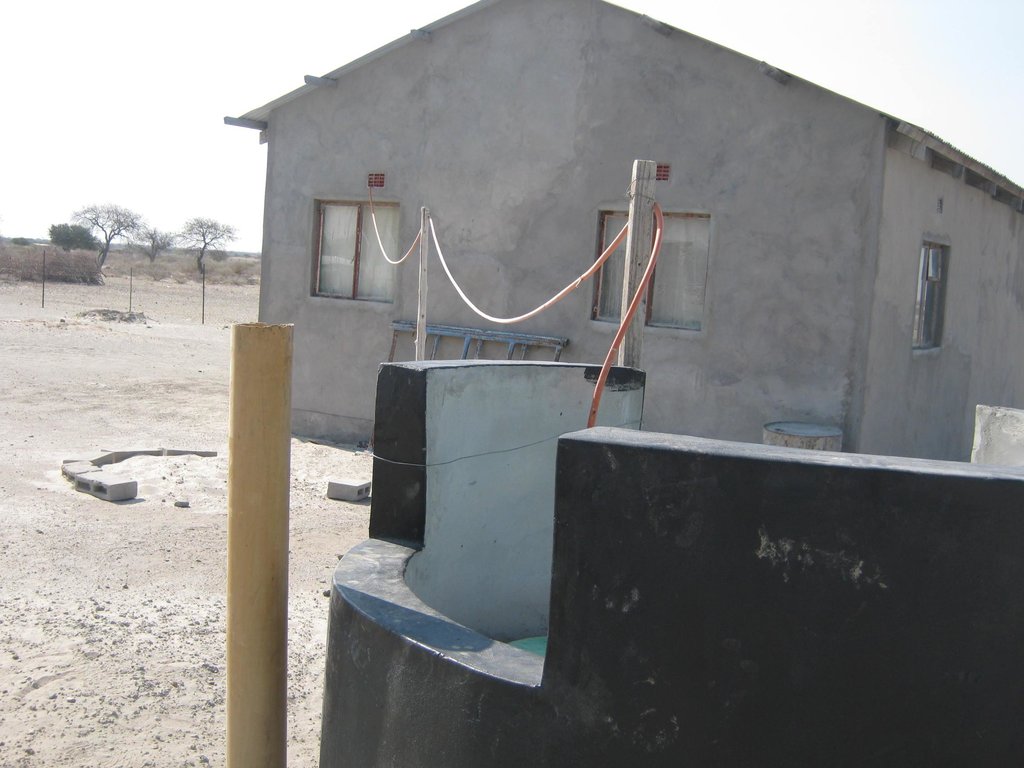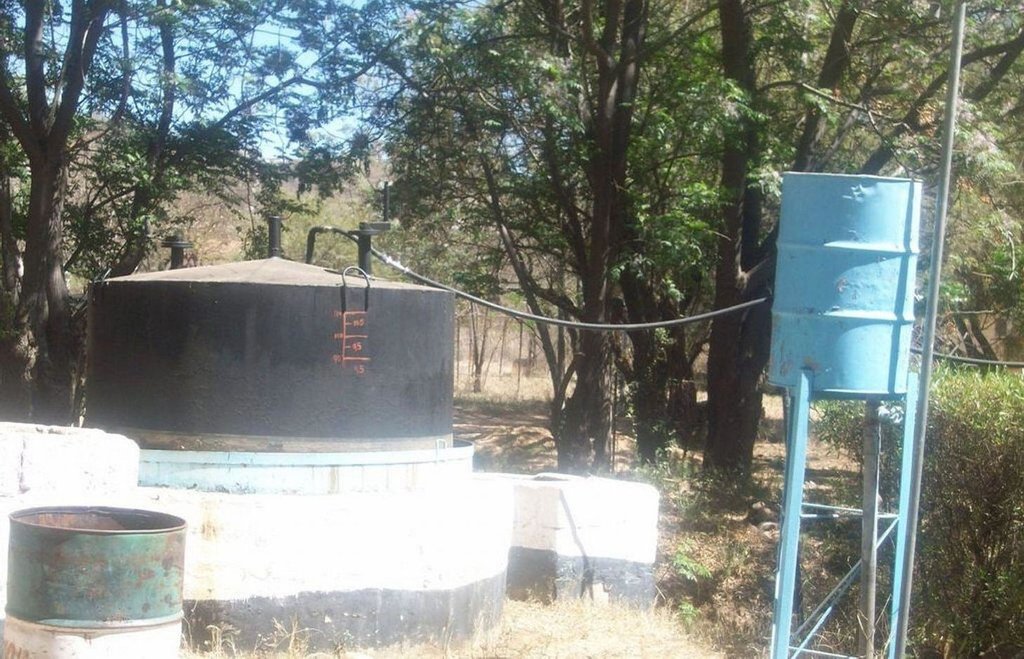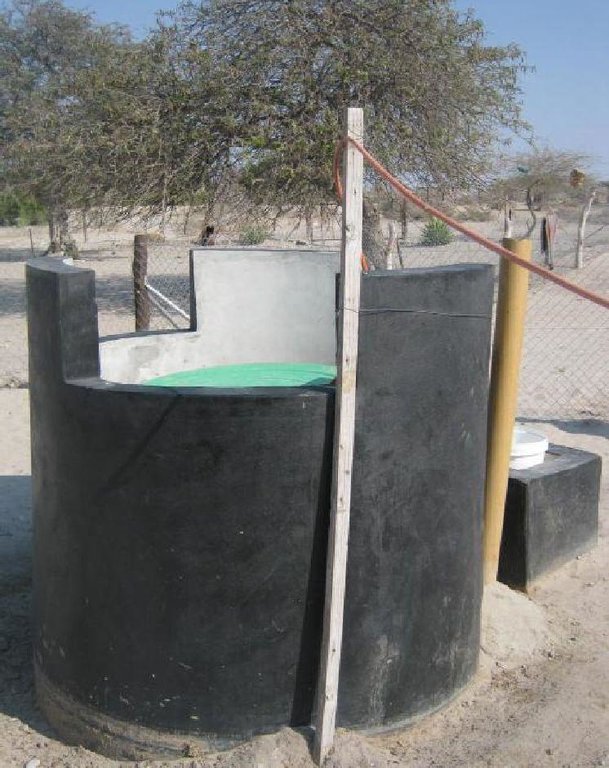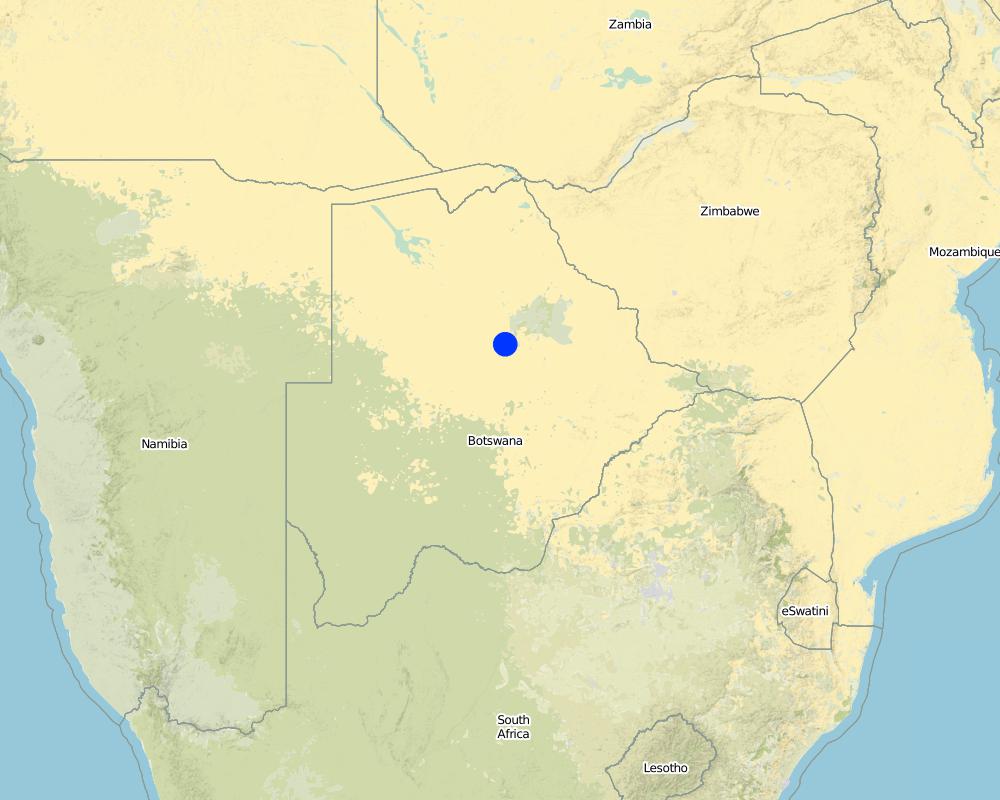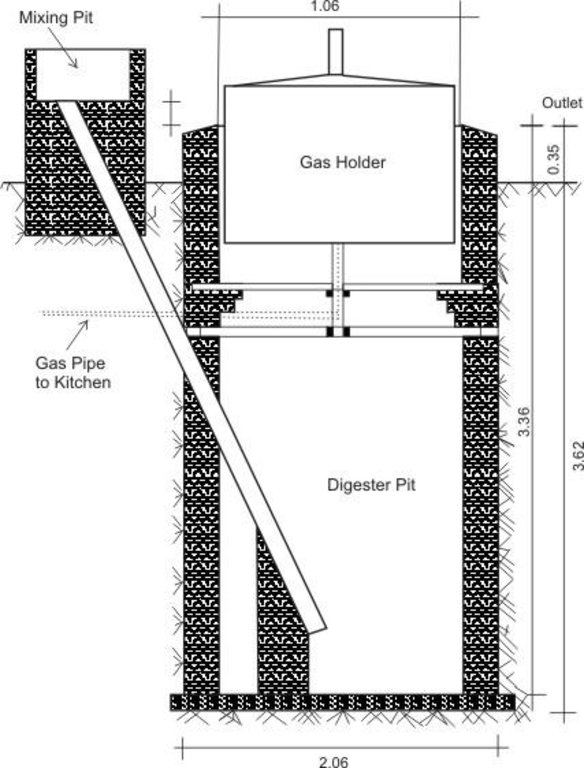Biogas [บอตสวานา]
- ผู้สร้างสรรค์:
- การอัพเดท:
- ผู้รวบรวม: Sebego Reuben
- ผู้เรียบเรียง: –
- ผู้ตรวจสอบ: Fabian Ottiger, Alexandra Gavilano
Gase ya Boloko (Setswana)
technologies_1521 - บอตสวานา
ดูส่วนย่อย
ขยายทั้งหมด ย่อทั้งหมด1. ข้อมูลทั่วไป
1.2 รายละเอียดที่ติดต่อได้ของผู้รวบรวมและองค์กรที่เกี่ยวข้องในการประเมินและการจัดเตรียมทำเอกสารของเทคโนโลยี
ผู้เชี่ยวชาญ SLM:
Mulale Kutlwano
บอตสวานา
ผู้เชี่ยวชาญ SLM:
Chanda Raban
University of Botswana
บอตสวานา
ชื่อของโครงการซึ่งอำนวยความสะดวกในการทำเอกสารหรือการประเมินเทคโนโลยี (ถ้าเกี่ยวข้อง)
DESIRE (EU-DES!RE)ชื่อขององค์กรซึ่งอำนวยความสะดวกในการทำเอกสารหรือการประเมินเทคโนโลยี (ถ้าเกี่ยวข้อง)
University of Botswana (University of Botswana) - บอตสวานา1.3 เงื่อนไขการใช้ข้อมูลที่ได้บันทึกผ่านทาง WOCAT
ผู้รวบรวมและวิทยากรหลักยอมรับเงื่อนไขเกี่ยวกับการใช้ข้อมูลที่ถูกบันทึกผ่านทาง WOCAT:
ใช่
2. การอธิบายลักษณะของเทคโนโลยี SLM
2.1 การอธิบายแบบสั้น ๆ ของเทคโนโลยี
คำจำกัดความของเทคโนโลยี:
Production of methane gas from cow-dung for use in house-hold cooking, heating and lighting in order to reduce fire wood demand
2.2 การอธิบายแบบละเอียดของเทคโนโลยี
คำอธิบาย:
Biogas plant: The biogas plant can be constructed in several ways as long as it can provide a medium for the biological material be digested. Biogas is the name given to the gas that is produced during the decomposition of some organic waste specifically to produce methane gas. The gas is then captured in a storage tank (on site) to be used for household energy needs. In many parts of the world where this technology is used (including Botswana) the most common form of input material is cow dung making it more appropriate for rural environments.
Purpose of the Technology: Advantages: the technology offers two major advantages; first, at every level of use i.e. individual or institutional, savings in terms of energy is realized. The only costs that are borne are at installation, otherwise input of cow dung has a minimal cost of collection (if any at all). The second advantage is that there is reduced usage of fuel wood which translates into less cutting down of trees leading to reduced deforestation and degradation of land. A disadvantage is the initial investment which is significant for poor farmers.
Establishment / maintenance activities and inputs: Construction of the biogas plant: construction of the plant consists of three main chambers: namely, the Digester pit where all the microbiological reactions or decomposition of the material takes place. The digester has to be built to be air-tight with the released gas only escaping into the gas holder. The gas holder is connected to the digester by way of a pipe. Its main purpose is to collect all the gas that has been fermented. The mixing pit is the input chamber where the dung is mixed with water and fed into the digester. The amount and quality of water required for this is no constraint, even in this water stressed area. Construction the biogas plant has to be done according to specifications. A technical drawing of the plant is shown on page 3. The purpose of the technology is to use it for house-hold energy (for cooking, lighting and running appliances).
Natural / human environment: In Botswana the technology was introduced by the Rural Industries Innovation Center which is a government funded research institution. Despite the existence of this company for many years, the uptake has been very low due to poor marketing and extension services and lack of financial assistance to poor farmers.
Biogas is suitable either for a farm, cattle post or rural setting where the inputs (cow dung) are easily available. But there are possibilities of experimenting with other bio-degradable materials in major centres where cow dung is not readily available.
2.3 รูปภาพของเทคโนโลยี
2.5 ประเทศภูมิภาค หรือสถานที่ตั้งที่เทคโนโลยีได้นำไปใช้และได้รับการครอบคลุมโดยการประเมินนี้
ประเทศ:
บอตสวานา
ภูมิภาค/รัฐ/จังหวัด:
Southern District
ข้อมูลจำเพาะเพิ่มเติมของสถานที่ตั้ง :
Kanye village
ระบุการกระจายตัวของเทคโนโลยี:
- ใช้ ณ จุดที่เฉพาะเจาะจงหรือเน้นไปยังบริเวณพื้นที่ขนาดเล็ก
แสดงความคิดเห็น:
Total area covered by the SLM Technology is 0 km2.
This technology is basically on a point location, even though it is to benefit a wider area in terms of conservation
Map
×2.6 วันที่การดำเนินการ
ถ้าไม่รู้ปีที่แน่นอน ให้ระบุวันที่โดยประมาณ:
- 10-50 ปี
2.7 คำแนะนำของเทคโนโลยี
ให้ระบุว่าเทคโนโลยีถูกแนะนำเข้ามาอย่างไร:
- ทางโครงการหรือจากภายนอก
ความคิดเห็น (ประเภทของโครงการ เป็นต้น) :
The technology is promoted by a government funded NGO, but has its origins outside the country
3. การจัดประเภทของเทคโนโลยี SLM
3.1 วัตถุประสงค์หลักของเทคโนโลยี
- ลด ป้องกัน ฟื้นฟู การเสื่อมโทรมของที่ดิน
- อนุรักษ์ระบบนิเวศน์
- สร้างผลกระทบทางด้านเศรษฐกิจที่เป็นประโยชน์
3.2 ประเภทของการใช้ที่ดินในปัจจุบันที่ได้นำเทคโนโลยีไปใช้
Land use mixed within the same land unit:
ใช่
Specify mixed land use (crops/ grazing/ trees):
- การปลูกพืชร่วมกับปศุสัตว์และการทำป่าไม้ (Agro-silvopastoralism)

พื้นที่ปลูกพืช
จำนวนของฤดูเพาะปลูกต่อปี:
- 1
ระบุ:
Longest growing period in days: 179 Longest growing period from month to month: Oct - Mar

ทุ่งหญ้าเลี้ยงสัตว์
Extensive grazing:
- กึ่งโนแมนดิซึ่มหรือแพสโตแรลลิซึ่ม (Semi-nomadism/pastoralism)
Animal type:
- cattle - non-dairy beef
- goats
- mules and asses
- poultry
- sheep

ป่า/พื้นที่ทำไม้
ผลิตภัณฑ์และบริการ:
- ไม้ที่นำมาทำเป็นเชื้อเพลิง
- ผลไม้และถั่ว
- การแทะเล็มหญ้า / การเก็บกินหญ้า
แสดงความคิดเห็น:
Major land use problems (compiler’s opinion): Overgrazing of the commons, droughts, saline water and over-harvesting of fuelwood for cooking, heating leading to deforestation and land degradation
Major land use problems (land users’ perception): Overgrazing of the commons, droughts, saline water and over-harvesting of fuelwood for cooking, heating leading to deforestation and land degradation.
Grazingland comments: Biogass technology is not applied in the Boteti area at the moment, only at DESIRE test site.
Selective felling of (semi-) natural forests: specific tree species are felled for fuelwood even though people are supposed to take only fallen-dead wood
Type of cropping system and major crops comments: Mixed cropping is the traditional practice but government extension advice promotes monocropping which the majority find expensive and risky.
Type of grazing system comments: Biogass technology is not applied in the Boteti area at the moment, only at DESIRE test site.
Constraints of settlement / urban
Livestock density: 1-10 LU /km2
3.4 การใช้น้ำ
การใช้น้ำของที่ดินที่มีการใช้เทคโนโลยีอยู่:
- จากน้ำฝน
แสดงความคิดเห็น:
Water supply: Also post-flooding
3.5 กลุ่ม SLM ที่ตรงกับเทคโนโลยีนี้
- ประสิทธิภาพด้านพลังงาน
3.6 มาตรการ SLM ที่ประกอบกันเป็นเทคโนโลยี

มาตรการอนุรักษ์ด้วยโครงสร้าง
- S11: อื่น ๆ

มาตรการอนุรักษ์ด้วยการจัดการ
- M2: การเปลี่ยนแปลงของการจัดการหรือระดับความเข้มข้น
แสดงความคิดเห็น:
Main measures: management measures
3.7 รูปแบบหลักของการเสื่อมโทรมของที่ดินที่ได้รับการแก้ไขโดยเทคโนโลยี

การเสื่อมโทรมของดินทางด้านชีวภาพ
- Bc (Reduction of vegetation cover): การลดลงของจำนวนพืชที่ปกคลุมดิน
- Bs (Quality and species composition): องค์ประกอบหรือความหลากหลายทางคุณภาพและชนิดพันธุ์ลดลง
แสดงความคิดเห็น:
Main type of degradation addressed: Bc: reduction of vegetation cover, Bs: quality and species composition /diversity decline
Main causes of degradation: deforestation / removal of natural vegetation (incl. forest fires) (harvesting of fuelwood for cooking, sometimes live trees are harvested.), land tenure (Area is communal grazing land)
Secondary causes of degradation: over-exploitation of vegetation for domestic use (Trees are cut for bush fences), droughts (The study area is prone to droughts), poverty / wealth ((lack of alternative livelihood sources))
3.8 การป้องกัน การลดลง หรือการฟื้นฟูความเสื่อมโทรมของที่ดิน
ระบุเป้าหมายของเทคโนโลยีกับความเสื่อมโทรมของที่ดิน:
- ฟื้นฟูบำบัดที่ดินที่เสื่อมโทรมลงอย่างมาก
แสดงความคิดเห็น:
Secondary goals: prevention of land degradation, mitigation / reduction of land degradation
4. ข้อมูลจำเพาะด้านเทคนิค กิจกรรมการนำไปปฏิบัติใช้ ปัจจัยนำเข้า และค่าใช้จ่าย
4.1 แบบแปลนทางเทคนิคของเทคโนโลยี
ข้อมูลจำเพาะด้านเทคนิค (แบบแปลนทางเทคนิคของเทคโนโลยี):
The diagram shows the technical layout of a biogas plant; showing the position of the main components: Digester, Gas holder, Mixing pit, and outlet. Cow dung & or kitchen waste (except bones) is mixed with water to form a sludge. This sludge is fed into the digester pit where decomposition and fermentation takes place. As the sludge ferments, methane gas is produced. Methane is a combustible gas and can therefore be used for cooking and lighting. Specially designed gas stoves and lanterns may be required as the gas would not be purified and hence ‚thicker‘ than commercially produced gasses. However, the design can include a water filled pipe bend (u shaped) between the gas holder and outlet pipe. The water in this pipe would help to purify the gas before it is fed to the household appliances. The gas holder tank floats in water, through which the gas bubbles escape and methane gas collects into the floating tank. An outlet through which decomposed material leaves the plant is necessary. Old sludge would float and be removed through this opening (Diagram drawn by G. Koorutwe, Department of Environmental Science, University of Botswana).
Location: Mopipi. Boteti Sub-District
Date: 05/10/11 (revised)
Technical knowledge required for field staff / advisors: high (Skilled technician is needed for installation)
Technical knowledge required for land users: moderate
Main technical functions: reduction of wood exploitation
Secondary technical functions: promotion of vegetation species and varieties (quality, eg palatable fodder), enhancement of tree growth
Structural measure: Digestion pit
Depth of ditches/pits/dams (m): 3.38
Width of ditches/pits/dams (m): 2.06
Structural measure: Gas holder
Depth of ditches/pits/dams (m): 2
Width of ditches/pits/dams (m): 1.6
Construction material (other): bricks, pipes, cement, iron sheets
Change of land use practices / intensity level: Use of biogass for cooking would lead to reduced cutting of wood for cooking
ผู้เขียน:
Reuben J. Sebego, Gaborone, Botswana
4.2 ข้อมูลทั่วไปเกี่ยวกับการคำนวณปัจจัยนำเข้าและค่าใช้จ่าย
อื่นๆ หรือสกุลเงินประจำชาติ (ระบุ):
Pula
If relevant, indicate exchange rate from USD to local currency (e.g. 1 USD = 79.9 Brazilian Real): 1 USD =:
6.5
ระบุค่าเฉลี่ยของค่าจ้างในการจ้างแรงงานต่อวัน:
1.08
4.3 กิจกรรมเพื่อการจัดตั้ง
| กิจกรรม | Timing (season) | |
|---|---|---|
| 1. | Construction | N/A |
4.4 ค่าใช้จ่ายของปัจจัยนำเข้าที่จำเป็นสำหรับการจัดตั้ง
| ปัจจัยนำเข้า | หน่วย | ปริมาณ | ค่าใช้จ่ายต่อหน่วย | ค่าใช้จ่ายทั้งหมดต่อปัจจัยนำเข้า | %ของค่าใช้จ่ายที่ก่อให้เกิดขึ้นโดยผู้ใช้ที่ดิน | |
|---|---|---|---|---|---|---|
| แรงงาน | Labour | Tank | 1.0 | 198.0 | 198.0 | 100.0 |
| อุปกรณ์ | Tank | Tank | 1.0 | 615.0 | 615.0 | 100.0 |
| อุปกรณ์ | Bricks | Tank | 1.0 | 77.0 | 77.0 | 100.0 |
| อุปกรณ์ | Cement | Tank | 1.0 | 123.0 | 123.0 | 100.0 |
| อุปกรณ์ | Plumbing material | Tank | 1.0 | 154.0 | 154.0 | 100.0 |
| วัสดุสำหรับก่อสร้าง | Earth | Tank | 1.0 | 31.0 | 31.0 | 100.0 |
| ค่าใช้จ่ายทั้งหมดของการจัดตั้งเทคโนโลยี | 1198.0 | |||||
| Total costs for establishment of the Technology in USD | 184.31 | |||||
แสดงความคิดเห็น:
Duration of establishment phase: 0.5 month(s)
4.5 การบำรุงรักษาสภาพหรือกิจกรรมที่เกิดขึ้นเป็นประจำ
| กิจกรรม | ช่วงระยะเวลา/ความถี่ | |
|---|---|---|
| 1. | Filling up with cow dung and water | 1 Day |
4.6 ค่าใช้จ่ายของปัจจัยนำเข้าและกิจกรรมที่เกิดขึ้นเป็นประจำที่ต้องการการบำรุงรักษา (ต่อปี)
| ปัจจัยนำเข้า | หน่วย | ปริมาณ | ค่าใช้จ่ายต่อหน่วย | ค่าใช้จ่ายทั้งหมดต่อปัจจัยนำเข้า | %ของค่าใช้จ่ายที่ก่อให้เกิดขึ้นโดยผู้ใช้ที่ดิน | |
|---|---|---|---|---|---|---|
| อุปกรณ์ | Cow dung | Tank | 1.0 | 33.0 | 33.0 | 100.0 |
| ค่าใช้จ่ายทั้งหมดของการบำรุงรักษาสภาพเทคโนโลยี | 33.0 | |||||
| Total costs for maintenance of the Technology in USD | 5.08 | |||||
แสดงความคิดเห็น:
Costs were calculated for labour and material based on the real cost of construction at the Mopipi Site.
4.7 ปัจจัยสำคัญที่สุดที่มีผลกระทบต่อค่าใช้จ่าย
ปัจจัยสำคัญที่สุดที่มีผลกระทบต่อค่าใช้จ่ายต่างๆ:
Material, labour and equipment used in construction are the most determining factors affecting the costs (installation cost is US$ 1198).
5. สิ่งแวดล้อมทางธรรมชาติและของมนุษย์
5.1 ภูมิอากาศ
ฝนประจำปี
- < 250 ม.ม.
- 251-500 ม.ม.
- 501-750 ม.ม.
- 751-1,000 ม.ม.
- 1,001-1,500 ม.ม.
- 1,501-2,000 ม.ม.
- 2,001-3,000 ม.ม.
- 3,001-4,000 ม.ม.
- > 4,000 ม.ม.
ข้อมูลจำเพาะ/ความคิดเห็นเรื่องปริมาณน้ำฝน:
Seasonal summer rains, approx six months dry (LPG = 75-179)
เขตภูมิอากาศเกษตร
- กึ่งแห้งแล้ง
Thermal climate class: subtropics. Sub-tropical climate. Semi-arid with dry winters (LPG=75-179 days).
5.2 สภาพภูมิประเทศ
ค่าเฉลี่ยความลาดชัน:
- ราบเรียบ (0-2%)
- ลาดที่ไม่ชัน (3-5%)
- ปานกลาง (6-10%)
- เป็นลูกคลื่น (11-15%)
- เป็นเนิน (16-30%)
- ชัน (31-60%)
- ชันมาก (>60%)
ธรณีสัณฐาน:
- ที่ราบสูง/ที่ราบ
- สันเขา
- ไหล่เขา
- ไหล่เนินเขา
- ตีนเนิน
- หุบเขา
ระดับความสูง:
- 0-100 เมตร
- 101-500 เมตร
- 501-1,000 เมตร
- 1,001-1,500 เมตร
- 1,501-2,000 เมตร
- 2,001-2,500 เมตร
- 2,501-3,000 เมตร
- 3,001-4,000 เมตร
- > 4,000 เมตร
ความคิดเห็นและข้อมูลจำเพาะเพิ่มเติมเรื่องสภาพภูมิประเทศ:
Altitudinal zone: 501-1000 m a.s.l. (Part of the Makgadikgadi basin)
Slopes on average: Flat (ranked 1, mainly low lying land of lucrustrine (pans) formation) and gentle (ranked 2, gently sloping (plains))
5.3 ดิน
ค่าเฉลี่ยความลึกของดิน:
- ตื้นมาก (0-20 ซ.ม.)
- ตื้น (21-50 ซ.ม.)
- ลึกปานกลาง (51-80 ซ.ม.)
- ลึก (81-120 ซ.ม.)
- ลึกมาก (>120 ซ.ม.)
เนื้อดิน (ดินชั้นบน):
- หยาบ/เบา (ดินทราย)
- ละเอียด/หนัก (ดินเหนียว)
อินทรียวัตถุในดิน:
- ปานกลาง (1-3%)
- ต่ำ (<1%)
(ถ้ามี) ให้แนบคำอธิบายเรื่องดินแบบเต็มหรือระบุข้อมูลที่มีอยู่ เช่น ชนิดของดิน ค่า pH ของดินหรือความเป็นกรดของดิน ความสามารถในการแลกเปลี่ยนประจุบวก ไนโตรเจน ความเค็ม เป็นต้น:
Soil depth on average: Shallow (ranked 1, generally soils are 40cm deep, underneath is a calcrete layer at about 40cm deep) and deep (ranked 2, some sandy area away from pans e.g. the Gidikwe Ridge )
Soil texture: Coarse/light (ranked 1, away from pans/river/flood plain = main soil type) and fine/heavy (ranked 2, sticky when wet in the depression)
Soil fertility: Low (ranked 1, sandy areas (Arenosols)) and medium (ranked 2, in flood plains of the Boteti river)
Topsoil organic matter: Low (ranked 1, low on sandy areas/soils) and topsoil organic matter (ranked 2, on the flood plains for molapo farming)
Soil drainage/infiltration: Good (ranked 1, very good on sandy soils) and medium (ranked 2, flood plains are medium)
Soil water storage capacity: Very low (ranked 1, on sandy soils) and medium (ranked 2, on flood plains)
5.4 ความเป็นประโยชน์และคุณภาพของน้ำ
ระดับน้ำใต้ดิน:
> 50 เมตร
น้ำไหลบ่าที่ผิวดิน:
ไม่ดีหรือไม่มีเลย
คุณภาพน้ำ (ที่ยังไม่ได้บำบัด):
เป็นน้ำเพื่อการดื่มที่ไม่ดี (จำเป็นต้องได้รับการบำบัด)
ความคิดเห็นและข้อมูลจำเพาะเพิ่มเติมเรื่องคุณภาพและปริมาณน้ำ:
Ground water table: >50m (ranked 1, for Boreholes) and 5-50 m (ranked 2, wells in the Boteti River bed)
Availability of surface water: poor/none (dry season-unreliable river flow/rainfall)
Water quality (untreated): Poor drinking water (treatement required, salty water in most areas, ranked 1) and unusable (sometimes too salty even for livestock consumption, ranked 2)
5.5 ความหลากหลายทางชีวภาพ
ความหลากหลายทางชนิดพันธุ์:
- สูง
ความคิดเห็นและข้อมูลจำเพาะเพิ่มเติมของความหลากหลายทางชีวภาพ:
Biodiversity: High (several game reserves (protected areas) nearby, ranked 1) and low (grazing areas with arable agriculture, ranked 2)
5.6 ลักษณะของผู้ใช้ที่ดินที่นำเทคโนโลยีไปปฏิบัติใช้
รายได้ที่มาจากนอกฟาร์ม:
- < 10% ของรายได้ทั้งหมด
ระดับของความมั่งคั่งโดยเปรียบเทียบ:
- พอมีพอกิน
- รวยมาก
เป็นรายบุคคล/ครัวเรือน:
- เป็นรายบุคคล/ครัวเรือน
ระดับของการใช้เครื่องจักรกล:
- การใช้กำลังจากสัตว์
เพศ:
- หญิง
- ชาย
ระบุลักษณะอื่นๆที่เกี่ยวข้องของผู้ใช้ที่ดิน:
Land users applying the Technology are mainly Leaders / privileged
Difference in the involvement of women and men: There is no difference, as this is mainly a family thing or institutioanal like in schools and community halls
Population density: < 10 persons/km2
Annual population growth: 2% - 3%
10% of the land users are very rich and own 50% of the land (Cattle farmers).
60% of the land users are average wealthy and own 30% of the land (Most inhabitants).
30% of the land users are poor and own 20% of the land (Subsistance farm).
Off-farm income specification: Saves money for buying commercial gas and electric power. Helps conserve the forests. Limited off-farm income opportunities for everyone including non-adopters of the technology.
Level of mechanization: Animal traction (mostly donkeys for draught power)
Market orientation of annual cropping production system: Mixed (subsistence/commercial) Could be used/produced for domestic and commercial purposes.
Market orientation of grazing land production system: Subsistence and commercial/market
Market orientation of forest production system: Mixed (subsistence/commercial) in both cases use of biogas is approppriate
5.7 Average area of land used by land users applying the Technology
- < 0.5 เฮกตาร์
- 0.5-1 เฮกตาร์
- 1-2 เฮกตาร์
- 2-5 เฮกตาร์
- 5-15 เฮกตาร์
- 15-50 เฮกตาร์
- 50-100 เฮกตาร์
- 100-500 เฮกตาร์
- 500-1,000 เฮกตาร์
- 1,000-10,000 เฮกตาร์
- >10,000 เฮกตาร์
พิจารณาว่าเป็นขนาดเล็ก กลาง หรือขนาดใหญ่ (ซึ่งอ้างอิงถึงบริบทระดับท้องถิ่น):
- ขนาดใหญ่
แสดงความคิดเห็น:
Average area of land owned or leased by land users applying the Technology on grazing land
1000-10000 ha (ranked 1, cattle farmers in ranches and cattle posts)
15-50 ha (ranked 2, subsistence farmers)
Average area of land owned or leased by land users applying the Technology on cropland:
50-100 ha (ranked 1)
2-5 ha (ranked 2, on average)
5.8 กรรมสิทธิ์ในที่ดิน สิทธิในการใช้ที่ดินและสิทธิในการใช้น้ำ
กรรมสิทธิ์ในที่ดิน:
- เป็นแบบชุมชนหรือหมู่บ้าน
- รายบุคคล ไม่ได้รับสิทธิครอบครอง
สิทธิในการใช้ที่ดิน:
- เข้าถึงได้แบบเปิด (ไม่ได้จัดระเบียบ)
- รายบุคคล
สิทธิในการใช้น้ำ:
- เกี่ยวกับชุมชน (ถูกจัดระเบียบ)
- รายบุคคล
แสดงความคิดเห็น:
The SLM can be used by anybody - not specified to any group. Dual grazing rights is a problem (private ranchers can also use the commons).
5.9 การเข้าถึงบริการและโครงสร้างพื้นฐาน
สุขภาพ:
- จน
- ปานกลาง
- ดี
การศึกษา:
- จน
- ปานกลาง
- ดี
ความช่วยเหลือทางด้านเทคนิค:
- จน
- ปานกลาง
- ดี
การจ้างงาน (เช่น ภายนอกฟาร์ม):
- จน
- ปานกลาง
- ดี
ตลาด:
- จน
- ปานกลาง
- ดี
พลังงาน:
- จน
- ปานกลาง
- ดี
ถนนและการขนส่ง:
- จน
- ปานกลาง
- ดี
น้ำดื่มและการสุขาภิบาล:
- จน
- ปานกลาง
- ดี
บริการด้านการเงิน:
- จน
- ปานกลาง
- ดี
6. ผลกระทบและสรุปคำบอกกล่าว
6.1 ผลกระทบในพื้นที่ดำเนินการ (On-site) จากการใช้เทคโนโลยี
ผลกระทบทางด้านเศรษฐกิจและสังคม
การผลิต
การผลิตพืชผล
แสดงความคิดเห็น/ระบุ:
Assuming large scale removal of dung, there could be reduction in animal manure available for crop production
การผลิตพลังงาน
รายได้และค่าใช้จ่าย
ค่าใช่จ่ายของปัจจัยการผลิตทางการเกษตร
แสดงความคิดเห็น/ระบุ:
As farmers would have to purchase fertilizer as animal manure becomes scarce
ภาระงาน
แสดงความคิดเห็น/ระบุ:
With biogas no labour for fuelwood collection. Time and effort previously used for firewood collection is freed
ผลกระทบด้านสังคมวัฒนธรรมอื่น ๆ
SLM หรือความรู้เรื่องความเสื่อมโทรมของที่ดิน
การบรรเทาความขัดแย้ง
แสดงความคิดเห็น/ระบุ:
Future conflict over fuelwood resources would be averted. In case of no ownership of cattle.
สถานการณ์ของกลุ่มด้อยโอกาส ทางด้านสังคมและเศรษฐกิจ
แสดงความคิดเห็น/ระบุ:
Less demand on the time and labour of women and the girl child who are the main collecters of fuelwood
Gender related issues
แสดงความคิดเห็น/ระบุ:
Where taboos exist for women harvesting dung from kraals (livestock enclosure); this could constrain adoption along gender lines
Improved livelihoods and human well-being
แสดงความคิดเห็น/ระบุ:
Provides cheaper and alternative source of energy. Reduces workload for fuelwood collection for women and the girl child.
ผลกระทบด้านนิเวศวิทยา
วัฐจักรน้ำหรือน้ำบ่า
ปริมาณน้ำ
แสดงความคิดเห็น/ระบุ:
Due to reduced plant cover
ดิน
สิ่งปกคลุมดิน
แสดงความคิดเห็น/ระบุ:
More trees certaily provides soil cover. But problems possible when plant cover is reduced as a result of less manure
การหมุนเวียนและการเติมของธาตุอาหาร
แสดงความคิดเห็น/ระบุ:
Reduced soil fertility with distance from water points/kraals
ความเค็ม
อินทรียวัตถุในดิน/ต่ำกว่าดินชั้น C
แสดงความคิดเห็น/ระบุ:
Due to redused animal manure
ความหลากหลายทางชีวภาพของพืชและสัตว์
มวลชีวภาพ/เหนือดินชั้น C
แสดงความคิดเห็น/ระบุ:
Trees would have more density or cover
ความหลากหลายทางชีวภาพของพืช
แสดงความคิดเห็น/ระบุ:
Wood collectors target specific species
ลดความเสี่ยงของภัยพิบัติ
การปล่อยคาร์บอนและก๊าซเรือนกระจก
แสดงความคิดเห็น/ระบุ:
Large scale adoption of biogas production may introduce air pollution. Also unpleasent smell around the village.
ผลกระทบด้านนิเวศวิทยาอื่น ๆ
Concentration of nutrients (dung)
แสดงความคิดเห็น/ระบุ:
Cow dung will be reduce around water points and kraals
6.2 ผลกระทบนอกพื้นที่ดำเนินการ (Off-site) จากการใช้เทคโนโลยี
น้ำที่ใช้ประโยชน์ได้
การไหลของน้ำคงที่และสม่ำเสมอในช่วงฤดูแล้ง
การเกิดมลพิษในน้ำบาดาลหรือแม่น้ำ
ความสามารถต้านทานการเปลี่ยนแปลง / ความสามารถในการคัดกรอง
ตะกอนที่ถูกพัดพามาโดยลม
ความเสียหายต่อพื้นที่เพาะปลูกของเพื่อนบ้าน
6.3 การเผชิญและความตอบสนองของเทคโนโลยีต่อการเปลี่ยนแปลงสภาพภูมิอากาศที่ค่อยเป็นค่อยไป และสภาพรุนแรงของภูมิอากาศ / ภัยพิบัติ (ที่รับรู้ได้โดยผู้ใช้ที่ดิน)
การเปลี่ยนแปลงสภาพภูมิอากาศที่ค่อยเป็นค่อยไป
การเปลี่ยนแปลงสภาพภูมิอากาศที่ค่อยเป็นค่อยไป
| ฤดู | increase or decrease | เทคโนโลยีมีวิธีการรับมืออย่างไร | |
|---|---|---|---|
| อุณหภูมิประจำปี | เพิ่มขึ้น | ดี |
สภาพรุนแรงของภูมิอากาศ (ภัยพิบัติ)
ภัยพิบัติทางอุตุนิยมวิทยา
| เทคโนโลยีมีวิธีการรับมืออย่างไร | |
|---|---|
| พายุฝนประจำท้องถิ่น | ดี |
| พายุลมประจำท้องถิ่น | ดี |
ภัยพิบัติจากสภาพภูมิอากาศ
| เทคโนโลยีมีวิธีการรับมืออย่างไร | |
|---|---|
| ภัยจากฝนแล้ง | ดี |
ภัยพิบัติจากน้ำ
| เทคโนโลยีมีวิธีการรับมืออย่างไร | |
|---|---|
| น้ำท่วมตามปกติ (แม่น้ำ) | ดี |
ผลลัพธ์ตามมาที่เกี่ยวข้องกับภูมิอากาศอื่น ๆ
ผลลัพธ์ตามมาที่เกี่ยวข้องกับภูมิอากาศอื่น ๆ
| เทคโนโลยีมีวิธีการรับมืออย่างไร | |
|---|---|
| ช่วงการปลูกพืชที่ลดลงมา | ดี |
| temperature decrease | ไม่ค่อยดี |
แสดงความคิดเห็น:
Biogas technology may be limited under extreme cold conditions whereby fermentation may be limited by cold temperatures.
6.4 การวิเคราะห์ค่าใช้จ่ายและผลประโยชน์ที่ได้รับ
ผลประโยชน์ที่ได้รับเปรียบเทียบกับค่าใช้จ่ายในการจัดตั้งเป็นอย่างไร (จากมุมมองของผู้ใช้ที่ดิน)
ผลตอบแทนระยะสั้น:
ด้านลบ
ผลตอบแทนระยะยาว:
ด้านบวก
ผลประโยชน์ที่ได้รับเปรียบเทียบกับค่าใช้จ่ายในการบำรุงรักษาหรือต้นทุนที่เกิดขึ้นซ้ำอีก เป็นอย่างไร (จากมุมมองของผู้ใช้ที่ดิน)
ผลตอบแทนระยะสั้น:
ด้านบวก
ผลตอบแทนระยะยาว:
ด้านบวก
แสดงความคิดเห็น:
Very costly to set up, if no government aid. It is however very good for long term water provision.
6.5 การปรับตัวของเทคโนโลยี
ถ้ามีข้อมูลให้บอกปริมาณด้วย (จำนวนของครัวเรือนหรือครอบคลุมพื้นที่):
10
แสดงความคิดเห็น:
1% of land user families have adopted the Technology with external material support
10 land user families have adopted the Technology with external material support
Comments on acceptance with external material support: A very insignificant number of individual farmers have used this technology
Comments on spontaneous adoption: The technology has mostly been used where the Research institution has installed in farmers' properties. Only in very few instances around the country have individuals installed it for themselves.
There is a little trend towards spontaneous adoption of the Technology
Comments on adoption trend: There seems to be very little marketing of biogas in the country
6.7 จุดแข็ง / ข้อได้เปรียบ / โอกาสของเทคโนโลยี
| จุดแข็ง / ข้อได้เปรียบ / โอกาสในทัศนคติของผู้ใช้ที่ดิน |
|---|
|
Problems of diminishing firewood species are reduced. How can they be sustained / enhanced? Because it is not every or all species that is used for firewood, the targeted species are quickly diminished |
|
Cost of getting firewood is reduced How can they be sustained / enhanced? Distance to wood collection places are ever increasing hence users have to buy from truck or donkey cart owners |
|
More time is freed How can they be sustained / enhanced? This especially applies to children (of school going age) in that they would have more time for their home works. |
| จุดแข็ง / ข้อได้เปรียบ / โอกาสในทัศนคติของผู้รวบรวมหรือวิทยากรหลัก |
|---|
|
Low maintenance and inputs are required for this technology How can they be sustained / enhanced? There is need for promotion of the technology |
|
The structures to be put in place are very basic How can they be sustained / enhanced? There is need for the government to subsidize farmers in installing biogas plants, especially in the rual areas. |
|
Good for rural households where firewood is used extensively. How can they be sustained / enhanced? Improve income of rural families so that they could afford the technology |
6.8 จุดอ่อน / ข้อเสียเปรียบ / ความเสี่ยงของเทคโนโลยีและวิธีการแก้ไข
| จุดอ่อน / ข้อเสียเปรียบ / ความเสี่ยงในทัศนคติของผู้ใช้ที่ดิน | มีวิธีการแก้ไขได้อย่างไร |
|---|---|
| Too expensive for poor farmers to adopt without assistance | Donor/government subsidies |
7. การอ้างอิงและการเชื่อมต่อ
7.1 วิธีการและแหล่งข้อมูล
7.2 การอ้างอิงถึงสิ่งตีพิมพ์
หัวข้อ, ผู้เขียน, ปี, หมายเลข ISBN:
Brown, V. J., 2006. BIOGAS: A Bright Idea for Africa. Environ Health Perspectives. 114(5), pp. A300–A303.
ชื่อเรื่อง ผู้เขียน ปี ISBN:
internet
หัวข้อ, ผู้เขียน, ปี, หมายเลข ISBN:
Dayal, M., Vimal, O.P., Singh, K.K., 1989. Biomass gasification in India — DNES activities. Biomass, Volume 18, issues 3-4,pp. 197-204
ชื่อเรื่อง ผู้เขียน ปี ISBN:
http://www.ganesha.co.uk/Articles/Biogas%20Technology%20in%20India.htm
ลิงก์และโมดูล
ขยายทั้งหมด ย่อทั้งหมดลิงก์
ไม่มีลิงก์
โมดูล
ไม่มีโมดูล


